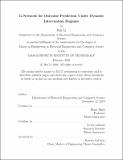| dc.contributor.advisor | Roger Mark and Li-wei Lehman. | en_US |
| dc.contributor.author | Li, Rui,M. Eng.Massachusetts Institute of Technology. | en_US |
| dc.contributor.other | Massachusetts Institute of Technology. Department of Electrical Engineering and Computer Science. | en_US |
| dc.date.accessioned | 2021-02-19T20:11:27Z | |
| dc.date.available | 2021-02-19T20:11:27Z | |
| dc.date.copyright | 2020 | en_US |
| dc.date.issued | 2020 | en_US |
| dc.identifier.uri | https://hdl.handle.net/1721.1/129838 | |
| dc.description | Thesis: M. Eng., Massachusetts Institute of Technology, Department of Electrical Engineering and Computer Science, February, 2020 | en_US |
| dc.description | Cataloged from student-submitted PDF of thesis. | en_US |
| dc.description | Includes bibliographical references (pages 56-57). | en_US |
| dc.description.abstract | Counterfactual prediction is useful in settings where one would like to know what would have happened had an alternative regime been followed, but one only knows the outcomes under the observational regime. Typically, the regimes are dynamic and time-varying. In these scenarios, G-computation can be used for counterfactual prediction. This work explores a novel recurrent neural network approach to G-computation, dubbed G-Net. Many implementations of G-Net were explored and compared to the baseline, linear regression. Two independent datasets were used to evaluate the performance of G-Net: one from a physiological simulator, CVSim, and another from the real-world MIMIC database. Results from the CVSim experiments suggest that G-Net outperforms the traditional linear regression approach to G-computation. The best G-Net model found from the CVSim experiments was then evaluated using the MIMIC dataset. The outcomes under a few different counterfactual strategies on the MIMIC cohort were explored and evaluated for clinical plausibility. | en_US |
| dc.description.statementofresponsibility | by Rui Li. | en_US |
| dc.format.extent | 57 pages | en_US |
| dc.language.iso | eng | en_US |
| dc.publisher | Massachusetts Institute of Technology | en_US |
| dc.rights | MIT theses may be protected by copyright. Please reuse MIT thesis content according to the MIT Libraries Permissions Policy, which is available through the URL provided. | en_US |
| dc.rights.uri | http://dspace.mit.edu/handle/1721.1/7582 | en_US |
| dc.subject | Electrical Engineering and Computer Science. | en_US |
| dc.title | G-Network for outcome prediction under dynamic intervention regimes | en_US |
| dc.type | Thesis | en_US |
| dc.description.degree | M. Eng. | en_US |
| dc.contributor.department | Massachusetts Institute of Technology. Department of Electrical Engineering and Computer Science | en_US |
| dc.identifier.oclc | 1237530470 | en_US |
| dc.description.collection | M.Eng. Massachusetts Institute of Technology, Department of Electrical Engineering and Computer Science | en_US |
| dspace.imported | 2021-02-19T20:10:57Z | en_US |
| mit.thesis.degree | Master | en_US |
| mit.thesis.department | EECS | en_US |
